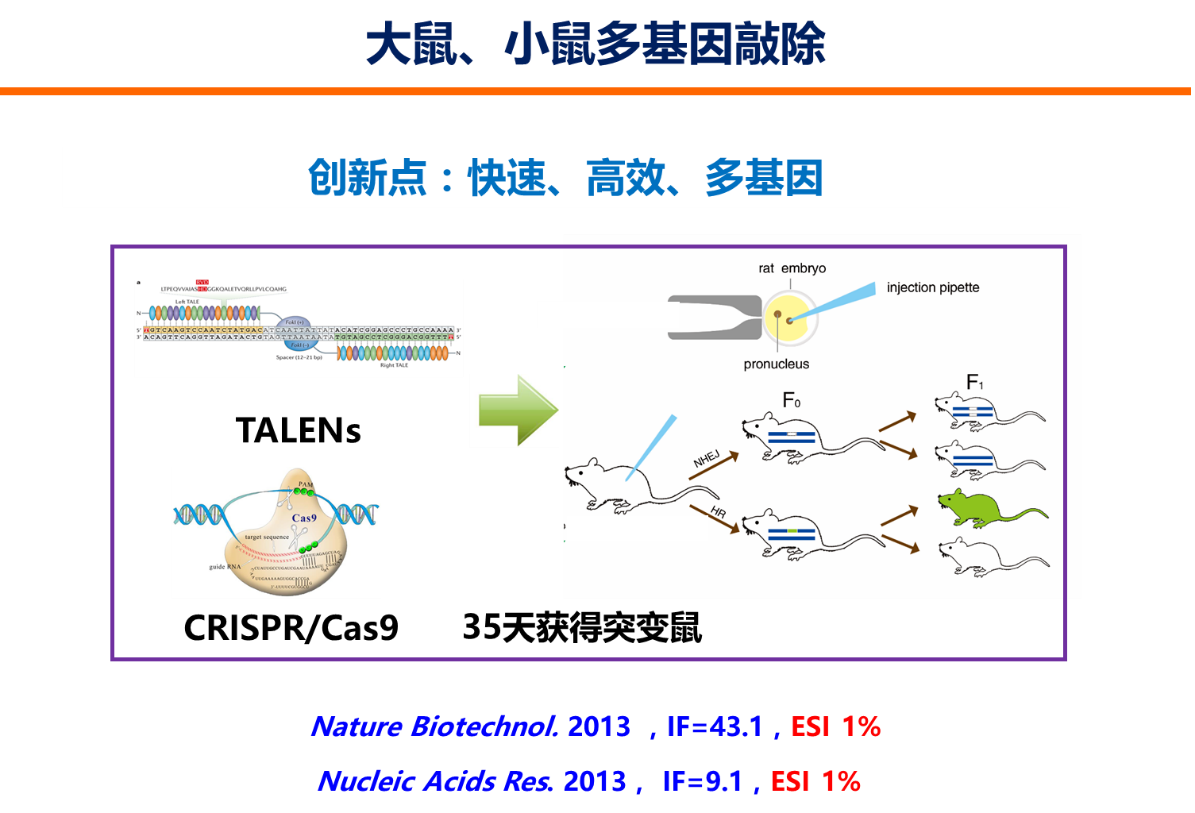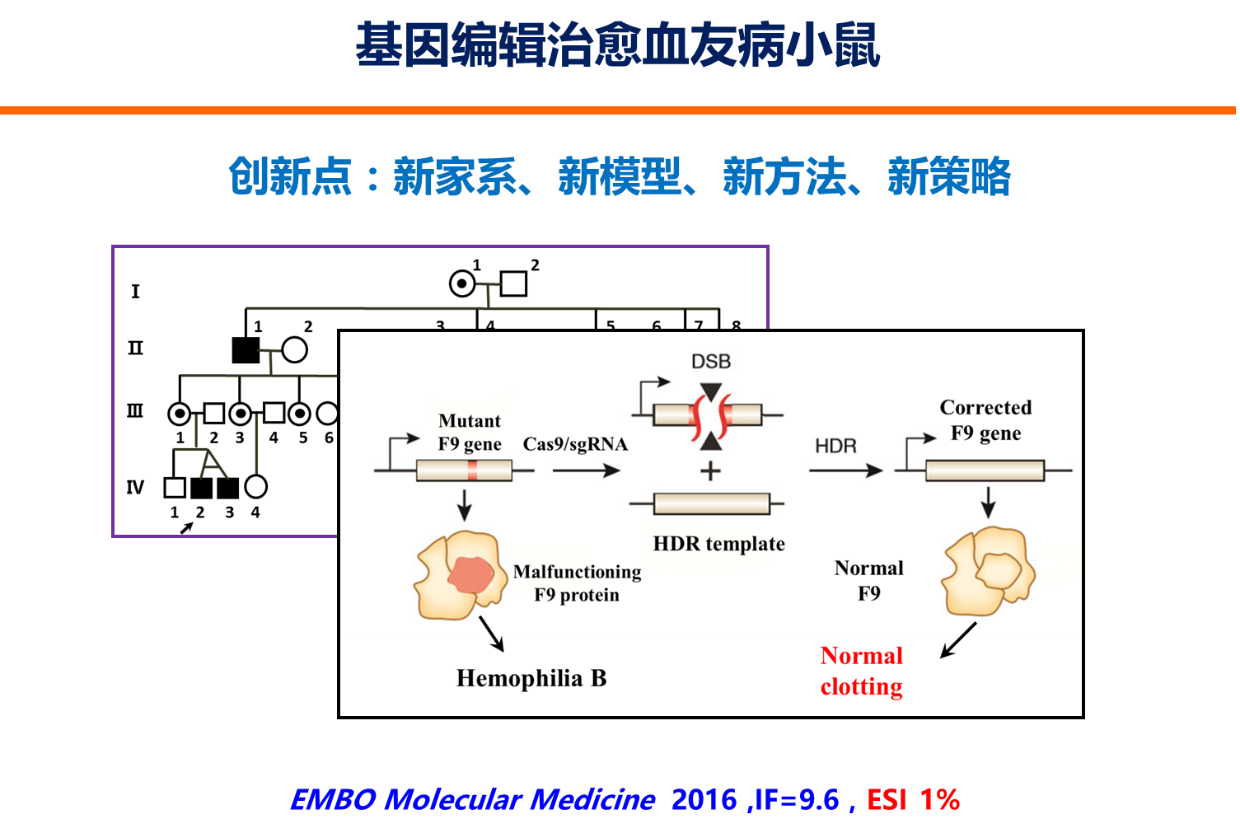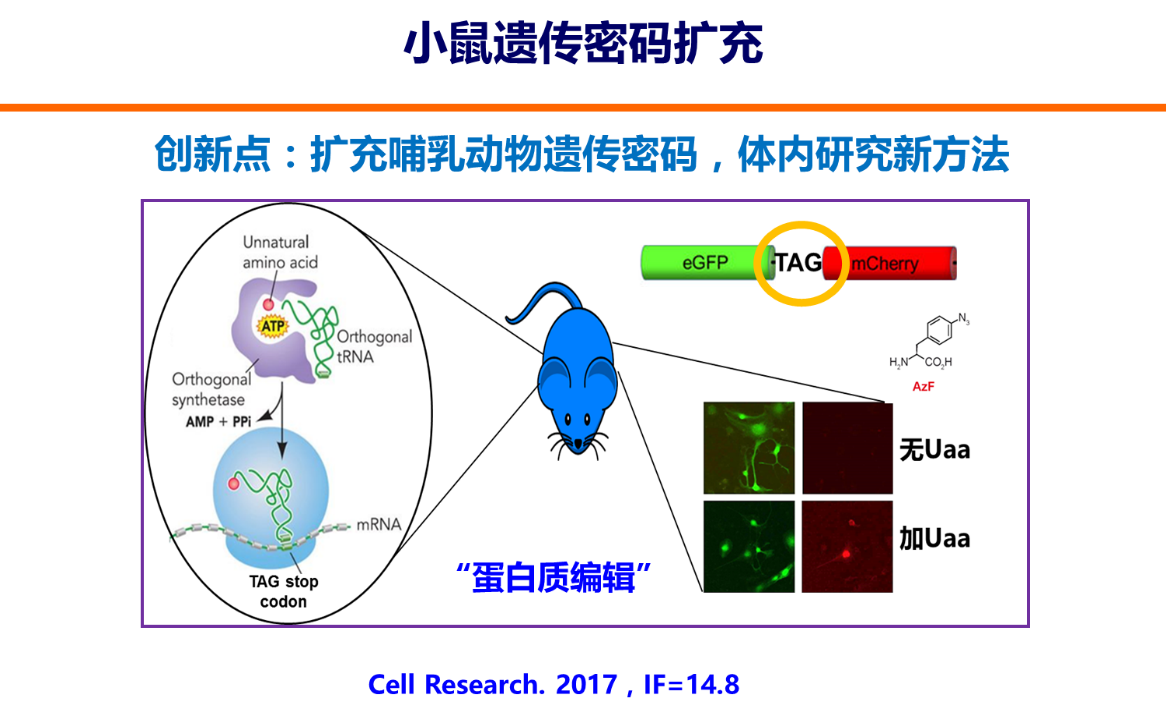| 基因编辑与成体干细胞课题组 课题组长:李大力 职称:研究员 职务:华东师范大学生命科学学院生命医学系主任 上海市调控生物学重点实验室常务副主任 研究方向:基因编辑与成体干细胞 地址:上海市东川路500号华东师范大学生命科学学院535室 200241 Email:dlli@bio.ecnu.edu.cn |
李大力,博士,2007年获湖南师范大学遗传学博士学位,博士期间在美国德州农工大学进行联合研究,毕业后受聘于华东师范大学生命科学学院从事教学与科研工作,2009和2014 年先后破格晋升为副教授、研究员,2016年获得教育部长江学者奖励计划青年项目资助。目前为华东师范大学实验动物中心主任,上海市调控生物学重点实验室副主任。近年来在国际知名生物学期刊Nature Biotechnology,Nucleic Acids Research和Cell Research等杂志上发表研究论文60余篇,在国际上率先建立了大鼠和小鼠基因编辑技术体系,并成功利用CRISPR/Cas9技术在动物模型中治愈遗传疾病。主持国家自然科学基金4项,上海市项目2项。Scientific Reports杂志编委,为Nature Biotechnology等国际知名期刊审稿。
近年来围绕基因编辑技术开展了一系列的研究工作,特别是在人类疾病动物模型构建以及基因治疗方面建立了新的技术体系。利用TALEN和CRISPR/Cas等基因编辑技术在国际上率先建立了快速高效的大鼠和小鼠基因修饰技术体系,实现大鼠多基因同时敲除。通过基因编辑技术定点修复突变基因在小鼠模型中治愈了血友病,为血友病的治疗提供了长效解决方案。证明在脊椎动物中扩充遗传密码子是稳定可行的,显著提高了遗传密码子扩充技术在高等动物中深度探索的可行性。目前发表SCI论文60余篇,其中第一或通讯作者(含共同)论文25篇,近五年来在Nature Biotechnology等杂志发表SCI论文30余篇,其中通讯作者论文22篇,3篇为ESI前1%高被引论文,最高他引350余次。申请基因编辑或基因治疗专利十余项,其中一项与Cas9相关发明专利已授权并转化。
个人荣誉:
教育部“长江学者奖励计划”青年学者
上海市普陀区拔尖人才
学术奖励
海南省科技进步奖(二等奖,排名第四):胚胎发育异常的分子机制及治疗研究
学术兼职:
Scientific Reports编委
Nature Biotechnology, Nature Protocols, Cell Research,Stem Cells等杂志审稿人
研究方向:
基因编辑技术体系开发与基因治疗研究
遗传密码扩充等新技术在动物模型中的应用
成体干细胞自我更新与分化的机理
主要研究成果:
遗传疾病基因治疗研究
目前全球大约有7000余种遗传疾病,其中95%以上的遗传病都没有有效的干预手段,更谈不上治愈,给家庭和社会带来沉重的负担。近几年欧洲已经出现了治疗遗传疾病的基因治疗药物,美国FDA也对基因治疗进行了突破性疗法认定,给遗传疾病治疗带来了希望。然而,通过不同方式递送治疗性基因片段的传统基因疗法存在随机整合引起的肿瘤风险,或者外源基因表达不稳定无法长时间产生疗效,限制着基因治疗方法的应用。如果能将突变基因原位修复或者将外源治疗性基因定点整合,将能有效解决制约基因治疗发展的短板。而基因治疗研究和疗效评价必需在活体动物中进行,快速构建合适动物模型也是研究的重点。针对基因治疗目前研究的困局,课题组在多个方面开展了深入研究,并取得了一定的成绩。
我们在国内率先建立基于TALEN的小鼠基因编辑技术:建立了基于TALEN技术的基因敲除小鼠和大鼠的技术平台(Nucleic Acids Res,2013)。在此基础上,利用TALEN技术构建了基因敲除大鼠的技术体系,开展以基因修饰小鼠和大鼠等两种模式动物的基础研究(SCI CHINA LIFE SCI,2016,最后通讯作者)。在国际上率先利用CRISPR/Cas技术构建基因修饰的大鼠和小鼠模型,证实了该体系在哺乳动物胚胎中的超强活性,能同时获得双基因同时突变的复合基因敲除大鼠。这是国际上第一次同时构建双基因敲除大鼠的报道,论文发表在《Nature Biotechnology》。应Nature Protocols等杂志邀请,撰写CRISPR/cas9技术构建基因修饰大鼠的操作规程,加速推动了该技术在大

鼠基因修饰中的应用,建立了很好的国际影响力(Nature Protocols,2014, Methods in Enzymology,2014)。获得CRISPR/Cas9发明专利一项并转化。通过这些工作,课题组能在5周内构建多基因敲除大鼠和小鼠模型,解决了人类疾病模型构建的技术问题。运用单碱基编辑工具ABE等,快速构建碱基精确转换的小鼠和大鼠的庞贝氏病等遗传疾病模型(Protein Cell,2018)。
证明Cas9基因编辑技术治疗遗传疾病的可行性:解决了动物模型构建技术之后,我们尝试利用基因编辑技术开展单基因遗传病的基因治疗研究。合作研究发现一个携带新的凝血因子九(F9)基因突变的B型血友病家系。利用基因编辑技术快速模拟病中的F9基因Y371D突变,构建新的B型血友病小鼠

模型。通过尾静脉注射将Cas9及修复模板导入到小鼠体内,修复部分肝细胞中F9突变使其正常表达而实现长期治愈。该论文证明利用Cas9 技术只需修复0.6%的肝细胞中的F9基因突变就有显著疗效(EMBO Molecular Medicine,2016)。该杂志还同期刊发了专家评论,认为我们的工作在遗传疾病治疗方面令人鼓舞。率先证明Cas9缺口酶(Cas9 nickase)可以激活动物体内同源重组用于在体基因治疗,同时极大降低了脱靶切割的风险(JBC,2018)。
脊椎动物中的遗传密码扩充
如何将具有特殊官能团的非天然氨基酸定点整合到活体动物某个蛋白质的特定氨基酸位点,赋予这些蛋白质以新的理化性质,是合成生物学与遗传学研

究的热点。课题组通过将仅能识别非天然氨基酸的tRNA(orthogonal tRNA)与氨酰tRNA合成酶(orthogonal synthetase)的正交体系整合到斑马鱼和小鼠基因组中,构建了可稳定遗传的动物品系。在分离的原代细胞和整体动物水平,以琥珀终止密码子UAG为编码非天然氨基酸p-azido-phenylalanine (AzF)的密码子,在特定的报告基因中插入AzF,证明在脊椎动物中扩充遗传密码子是稳定可行的,显著提高了遗传密码子扩充技术在高等动物中深度探索的可行性(Cell Research,2017)。论文刊出后Science杂志以“Editor’s Choice”的形式评论认为是本周合成生物学领域的重要进展。
成体干细胞自我更新与分化的机理
课题组围绕Wnt相关受体Lgr4基因敲除小鼠深入开展了生殖发育以及成体干细胞为主的研究。发现Lgr4基因缺失小鼠出生后睾丸体积和重量下降,成年后精子发育出现障碍而导致雄性不育,证明PMC中Lgr4/WNT信号通路起着至关重要的作用,提出该细胞类型可能作为细胞微环境,对精原干细胞的自我更新和分化起到调控作用的新观点(Development 2013);发现Lgr4主要在排卵后的卵巢颗粒细胞和黄体颗粒细胞中高表达,Lgr4基因的缺失导致WNT信号通路活性下降从而引起金属基质蛋白酶的表达下调,引起HB-EGF/ERK信号通路活性显著下降,使黄体颗粒细胞成熟过程受到抑制,而导致雌性不育(Endocrinology,2014者);发现Lgr4的缺失导致小鼠潘氏细胞分化受阻,引起Lgr5阳性的干细胞消失。通过遗传学或化学小分子处理方法重新激活下游的beta-catenin信号,Lgr4敲除小鼠潘氏细胞和肠干细胞的重新出现,进一步证明了Lgr4基因通过调控WNT信号通路参与小肠干细胞的维持以及潘氏细胞的分化(JBC,2013,Paper of the week)。研究了黏附GPCR受体Gpr126在血管发育和病理性血管新生过程中的功能和机理(JBC,2014)。目前,课题组以肠干细胞为模型,开展了多种信号通路调控成体干细胞维持和肿瘤发生发展的功能与机制研究。
代表性论文:
Li D*, Qiu Z, Shao Y, Chen Y, Guan Y, Liu M, Li Y, Gao N, Wang L, Lu X, Zhao Y*, Liu M*. Heritable gene targeting in the mouse and rat using a CRISPR-Cas system. Nature Biotechnology. 2013 ;31(8):681-3
Guan Y, Ma L, Li Q, Sun Z, Ma Li, Wu L, Wang L, Zeng L, Shao Y, Chen Y, Ma N, Lu W, Hu K, Han H, Yu Y, Huang Y, Liu M*, Li D*. CRISPR/Cas9 mediated somatic correction of a novel coagulator factor IX gene mutation ameliorates hemophilia in mouse. EMBO Mol Med. 2016 May 2;8(5):477-88
News&Views, Nguyen TH, Anegon I. Successful correction of hemophilia by CRISPR/Cas9 genome editing in vivo: delivery vector and immune responses are the key to success.EMBO Mol Med. 2016 May 2;8(5):439-41.) (杂志同期点评)
Chen Y, Ma J, Lu W, Tian M, Thauvin M, Yuan C, Volovitch M, Wang Q, Holst J, Liu M, Vriz S, Ye S*, Wang L*, Li D*. Heritable expansion of the genetic code in mouse and zebrafish. Cell Res. 2017 Feb;27(2):294-297.
Editor’s Choice, Valda Vinson, Expanding the genetic code in vertebrates, Science 2017:Vol. 355, Issue 6320, pp. 36
Shao Y, Guan Y, Wang L, Qiu Z, Liu M, Chen Y, Wu L, Li Y, Ma X, Liu M*, Li D*. Genome editing in the rat using CRISPR-Cas and injection of RNAs into one-cell embryos. Nature Protocols. 2014 (10):2493-512
Qiu Z, Liu M, Chen Z, Shao Y, Pan H, Wei G, Yu C, Zhang L, Li X, Wang P, Fan HY, Du B, Liu B, Liu M*, Li D*. High-efficiency and heritable gene targeting in mouse by transcription activator-like effector nucleases. Nucleic Acids Res. 2013 Jun;41(11):e120
论文列表:
2018
Zhang YL, Zhao LW, Zhang J, Le R, Ji SY, Chen C, Gao Y, Li D, Gao S, Fan HY. DCAF13 promotes pluripotency by negatively regulating SUV39H1 stability during early embryonic development.EMBO J. 2018 Aug 14. pii: e98981.
Yang L, Zhang X, Wang L, Yin S, Zhu B, Xie L, Duan Q, Hu H, Zheng R, Wei Y, Peng L, Han H, Zhang J, Qiu W, Geng H, Siwko S, Zhang X, Liu M, Li D*. Increasing targeting scope of adenosine base editors in mouse and rat embryos through fusion of TadA deaminase with Cas9 variants. Protein Cell. 2018 Sep;9(9):814-819. (Cover story, Highlight by Protein & Cell Volume 9, Issue 9, pp 752–753)
Shao Y, Wang L, Guo N, Wang S, Yang L, Li Y, Wang M, Yin S, Han H, Zeng L, Zhang L, Hui L, Ding Q, Zhang J, Geng H, Liu M*,Li D*. Cas9-nickase-mediated genome editing corrects hereditary tyrosinemia in rats. J Biol Chem. 2018, 293(18):6883-6892
Zhao Y, Yang Y, Xing R, Cui X, Xiao Y, Xie L, You P, Wang T, Zeng L, Peng W, Li D*, Chen H*, Liu M*. Hyperlipidemia induces typical atherosclerosis development in Ldlr and Apoe deficient rats. Atherosclerosis. 2018, 271:26-35.
Zhang DL, Sun YJ, Ma ML, Wang YJ, Lin H, Li RR, Liang ZL, Gao Y, Yang Z, He DF, Lin A, Mo H, Lu YJ, Li MJ, Kong W, Chung KY, Yi F, Li JY, Qin YY, Li J, Thomsen ARB, Kahsai AW, Chen ZJ, Xu ZG, Liu M, Li D*, Yu X*, Sun JP*. Gq activity- and β-arrestin-1 scaffolding-mediated ADGRG2/CFTR coupling are required for male fertility. Elife. 2018 Feb 2;7. pii: e33432
Wen H, Ma H, Cai Q, Lin S, Lei X, He B, Wu S, Wang Z, Gao Y, Liu W, Liu W, Tao Q, Long Z, Yan M, Li D, Kelley KW, Yang Y, Huang H, Liu Q. Nat Med. 2018 Jan 1. doi: 10.1038/nm.4456.
2017
Yue Z, Yuan Z, Zeng L, Wang Y, Lai L, Li J, Sun P, Xue X, Qi J, Yang Z, Zheng Y, Fang Y, Li D, Siwko S, Li Y, Luo J, Liu M. FASEB J. 2017 Dec 21.
Wei Y, Zhang XH, Li DL*. The 'new favorite' of gene editing technology-single base editors. Yi Chuan. 2017 Dec 20;39(12):1115-1121. (invited review)
Peng W, Li M, Li H, Tang K, Zhuang J, Zhang J, Xiao J, Jiang H, Li D, Yu Y, Sham PC, Nattel S, Xu Y. Dysfunction of Myosin Light-Chain 4 (MYL4) Leads to Heritable Atrial Cardiomyopathy With Electrical, Contractile, and Structural Components: Evidence From Genetically-Engineered Rats. J Am Heart Assoc. 2017 Oct 28;6(11).
Sun M, Ding J, Li D, Yang G, Cheng Z, Zhu Q. NUDT21 regulates 3'-UTR length and microRNA-mediated gene silencing in hepatocellular carcinoma. Cancer Lett. 2017 Dec 1;410:158-168.
Liu XM, Zhang YL, Ji SY, Zhao LW, Shang WN, Li D, Chen Z, Tong C, Fan HY. Mitochondrial Function Regulated by Mitoguardin-1/2 Is Crucial for Ovarian Endocrine Functions and Ovulation. Endocrinology. 2017 Nov 1;158(11):3988-3999
Liu Y, Fan C, Zhang Y, Yu X, Wu X, Zhang X, Zhao Q, Zhang H, Xie Q, Li M, Li X, Ding Q, Ying H, Li D, Zhang H. RIP1 kinase activity-dependent roles in embryonic development of Fadd-deficient mice. Cell Death Differ. 2017 Aug;24(8):1459-1469
Zhang X, Wang L, Liu M, Li D*. CRISPR/Cas9 system: a powerful technology for in vivo and ex vivo gene therapy. Sci China Life Sci. 2017 May;60(5):468-475 (invited review)
Zhang L, Li L, Gao G, Wei G, Zheng Y, Wang C, Gao N, Zhao Y, Deng J, Chen H, Sun J, Li D*, Zhang X*, Liu M*. Elevation of GPRC5A expression in colorectal cancer promotes tumor progression through VNN-1 induced oxidative stress. Int J Cancer. 2017 Jun 15;140(12):2734-2747 (Cover story)
Chen Y, Ma J, Lu W, Tian M, Thauvin M, Yuan C, Volovitch M, Wang Q, Holst J, Liu M, Vriz S, Ye S*, Wang L*, Li D*. Heritable expansion of the genetic code in mouse and zebrafish. Cell Res. 2017 Feb;27(2):294-297.
Lu J, Shao Y, Qin X, Liu D, Chen A, Li D*, Liu M*, Wang X*.CRISPR knockout rat cytochrome P450 3A1/2 model for advancing drug metabolism and pharmacokinetics research.Sci Rep. 2017 Feb 20;7:42922..
Chen R, Zhang Q, Duan X, York P, Chen GD, Yin P, Zhu H, Xu M, Chen P, Wu Q, Li D, Samarut J, Xu G, Zhang P, Cao X, Li J, Wong J. The 5-hydroxymethylcytosine (5hmC) reader Uhrf2 is required for normal levels of 5hmC in mouse adult brain and spatial learning and memory.J Biol Chem. 2017 Jan 23. pii: jbc.M116.754580
2016
Wei Y, Chen Y, Qiu Y, Zhao H, Liu G, Zhang Y, Meng Q, Wu G, Chen Y, Cai X, Wang H, Ying H, Zhou B, Liu M, Li D, Ding Q. Prevention of Muscle Wasting by CRISPR/Cas9-mediated Disruption of Myostatin In Vivo.Mol Ther. 2016 Nov;24(11):1889-1891.
You P, Hu H, Chen Y, Zhao Y, Yang Y, Wang T, Xing R, Shao Y, Zhang W, Li D*, Chen H*, Liu M*. Effects of Melanocortin 3 and 4 Receptor Deficiency on Energy Homeostasis in Rats. Sci Rep. 2016 Oct 7;6:34938.
Chen Y, Liu X, Zhang Y, Wang H, Ying H, Liu M, Li D, Lui KO, Ding Q. A Self-restricted CRISPR System to Reduce Off-target Effects. Mol Ther. 2016 Sep;24(9):1508-10.
Zhang L, Shao Y, Li L, Tian F, Cen J, Chen X, Hu D, Zhou Y, Xie W, Zheng Y, Ji Y, Liu M, Li D*, Hui L*. Efficient liver repopulation of transplanted hepatocyte prevents cirrhosis in a rat model of hereditary tyrosinemia type I. Sci Rep. 2016 Aug 11;6:31460
Chen Y, Lu W, Gao N, Long Y, Shao Y, Liu MZ, Chen H, Ye S, Ma X, Liu M*, Li D*. Generation of obese rat model by transcription activator-like effector nucleases targeting the leptin receptor gene. Sci China Life Sci. 2016 60(2):152-157.
Luo J, Yang Z, Ma Y, Yue Z, Lin H, Qu G, Huang J, Dai W, Li C, Zheng C, Xu L, Chen H, Wang J, Li D, Siwko S, Penninger JM, Ning G, Xiao J, Liu M. LGR4 is a receptor for RANKL and negatively regulates osteoclast differentiation and bone resorption. Nat Med. 2016 May;22(5):539-46
Zhang Y, Zeng Z, Zhao J, Li D, Liu M, Wang X.Measurement of Rhodamine 123 in Three-Dimensional Organoids: A Novel Model for P-Glycoprotein Inhibitor Screening.Basic Clin Pharmacol Toxicol. 2016 Apr 6.
Guan Y, Ma L, Li Q, Sun Z, Ma Li, Wu L, Wang L, Zeng L, Shao Y, Chen Y, Ma N, Lu W, Hu K, Han H, Yu Y, Huang Y, Liu M*, Li D*. CRISPR/Cas9 mediated somatic correction of a novel coagulator factor IX gene mutation ameliorates hemophilia in mouse. EMBO MOL MED. 2016 May 2;8(5):477-88.
Wang X*, Tang Y, Lu J, Shao Y, Qin X, Li Y, Wang L, Li D*,Liu M*. Characterization of novel cytochrome P450 2E1 knockout rat model generated by CRISPR/Cas9. Biochem Pharmacol. 2016 Apr 1;105:80-90.
Liu XM, Zhang YP, Ji SY, Li BT, Tian X, Li D, Tong C, Fan HY. Mitoguardin-1 and -2 promote maturation and the developmental potential of mouse oocytes by maintaining mitochondrial dynamics and functions. Oncotarget. 2016 Jan 12;7(2):1155-67.
2015
Wang L, Shao Y, Guan Y, Li L, Wu L, Chen F, Liu M, Chen H, Ma Y, Ma X, Liu M*, Li D*. Large genomic fragment deletion and functional gene cassette knock-in via Cas9 protein mediated genome editing in one-cell rodent embryos.Sci Rep. 2015 Dec 1;5:17517
Bai M, Li Q, Shao Y, Huang Y, Li D*, Ma Y*. Generation of site-specific mutant mice using the CRISPR/Cas9 system.Yi Chuan. 2015 Oct;37(10):1029-35.
Guan Y, Zhang L, Li X, Zhang X, Liu S, Gao N, Li L, Gao G, Wei G, Chen Z, Zheng Y, Ma X, Siwko S, Chen JL, Liu M*, Li D*.Repression of Mammalian Target of Rapamycin Complex 1 Inhibits Intestinal Regeneration in Acute Inflammatory Bowel Disease Models. J Immunol. 2015 May 29. pii: 1303356
Liu XM, Zhang YP, Ji SY, Li BT, Tian X,Li D, Tong C, Fan HY. Mitoguardin-1 and -2 promote maturation and the developmental potential of mouse oocytes by maintaining mitochondrial dynamics and functions.Oncotarget. 2015 doi: 10.18632/oncotarget.6713
Deng L, Jiang C, Chen L, Jin J, Wei J, Zhao L, Chen M, Pan W, Xu Y, Chu H, Wang X, Ge X, Li D, Liao L, Liu M, Li L, Wang P. The Ubiquitination of RagA GTPase by RNF152 Negatively Regulates mTORC1 Activation. Mol Cell. 2015 Jun 4;58(5):804-18
Fan G, Sun L, Shan P, Zhang X, Huan J, Zhang X, Li D, Wang T, Wei T, Zhang X, Gu X, Yao L, Xuan Y, Hou Z, Cui Y, Cao L, Li X, Zhang S, and Wang C. Loss of KLF14 triggers centrosome amplification and tumorigenesis. Nat Commun 2015 Oct 6;6:8450
Fang P, Xu W, Li D, Zhao X, Dai J, Wang Z, Yan X, Qin M, Zhang Y, Xu C, Wang L, Qiao Z. A novel acrosomal protein, IQCF1, involved in sperm capacitation and the acrosome reaction. Andrology. 2015 Mar;3(2):332-44.
2014
Guan Y, Shao Y, Li D*,Liu M*. Generation of Site-Specific Mutations in the Rat Genome Via CRISPR/Cas9. Methods Enzymol. 2014 ;546:297-317
Shao Y, Guan Y, Wang L, Qiu Z, Liu M, Chen Y, Wu L, Li Y, Ma X, Liu M*, Li D*. Genome editing in the rat using CRISPR-Cas and injection of RNAs into one-cell embryos. Nature Protocols. 2014 (10):2493-512
Cui H, Wang Y, Huang H, Yu W, Bai M, Zhang L, Bryan BA, Wang Y, Luo J, Li D*, Ma Y*, Liu M*.GPR126 Regulates Developmental and Pathological Angiogenesis through Modulation of VEGFR2 Signaling. J Biol Chem.2014 Sep 12. pii: jbc.M114.571000
Guan X, Duan Y, Zeng Q, Pan H, Qian Y, Li D*, Cao X*, Liu M*. Lgr4 Deficiency Induces Ataxia-like Phenotype in Mice and Impairs Long-term Depression at Cerebellar Parallel fiber-Purkinje Cell Synapses.J Biol Chem. 2014 Sep 19;289(38):26492-504.
Pan H, Cui H, Liu S, Qian Y, Wu H, Li L, Guan Y, Guan X, Zhang L, Fan HY, Ma Y, Li R, Liu M*,Li D*. Lgr4 gene regulates Corpus Luteum Maturation through Modulation of the WNT mediated EGFR-ERK Signaling Pathway. Endocrinology. 2014 May 30:en20132183.
Yi T, Weng J, Siwko S, Luo J, Li D, Liu M.LGR4/GPR48 inactivation leads to aniridia-genitourinary anomalies-mental retardation syndrome defects. J Biol Chem. 2014 Mar 28;289(13):8767-80
2013
Li D*, Qiu Z, Shao Y, Chen Y, Guan Y, Liu M, Li Y, Gao N, Wang L, Lu X, Zhao Y*, Liu M*. Heritable gene targeting in the mouse and rat using a CRISPR-Cas system. Nature Biotechnol. 2013 ;31(8):681-3.
Qiu Z, Liu M, Chen Z, Shao Y, Pan H, Wei G, Yu C, Zhang L, Li X, Wang P, Fan HY, Du B, Liu B, Liu M, Li D*. High-efficiency and heritable gene targeting in mouse by transcription activator-like effector nucleases. Nucleic Acids Res. 2013 Jun;41(11):e120.
Liu S, Qian Y, Li L, Wei G, Guan Y, Pan H, Guan X, Zhang L, Lu X, Zhao Y, Liu M*, Li D*.Lgr4 deficiency increases susceptibility and severity of dextran sodium sulphate induced inflammatory bowel disease in mice. J Biol Chem. 2013 288: 8794-8803. [paper of the week]
Qian Y, Liu S, Guan Y, Pan H, Guan X, Qiu Z, Li L, Gao N, Zhao Y, Li X, Lu Y, Liu M*, Li D.* Lgr4 mediated Wnt/β-catenin signaling in peritubular myoid cells is essential for spermatogenesis. Development. 2013;140(8):1751-61.
Luo W, Rodriguez M, Valdez JM, Zhu X, Tan K, Li D, Siwko S, Xin L, Liu M. Lgr4 is a Key Regulator of Prostate Development and Prostate Stem Cell Differentiation. Stem Cells. 2013;31(11):2492-505.
Wang Y, Dong J, Li D, Lai L, Siwko S, Li Y, Liu M. Lgr4 regulates mammary gland development and stem cell activity through the pluripotency transcription factor Sox2. Stem Cells. 2013;31(9):1921-31.
Du B, Luo W, Li R, Tan B, Han H, Lu X, Li D, Qian M, Zhang D, Zhao Y, Liu M. Lgr4/Gpr48 negatively regulates TLR2/4-associated pattern recognition and innate immunity by targeting CD14 expression. J Biol Chem. 2013; 288(21):15131-41.
2013年以前
Yu W, Qiu Z, Gao N, Wang L, Cui H, Qian Y, Jiang L, Luo J, Yi Z, Lu H, Li D*, and Liu M* PAK1IP1, a ribosomal stress-induced nucleolar protein, regulates cell proliferation via the p53-MDM2 loop, Nucleic Acids Res 2010 39(6):2234-48.
Yang Z, Li C, Wang X, Zhai C, Yi Z, Wang L, Liu B, Du B, Wu H, Guo X, Liu M, Li D*, Luo J*. Dauricine induces apoptosis, inhibits proliferation and invasion through inhibiting NF-kappaB signaling pathway in colon cancer cells. J Cell Physiol. 2010 Oct;225(1):266-75.
Li, D., Yu, W. and Liu, M. (2009) Regulation of KiSS1 gene expression. Peptides, 30, 130-138.
Li, D*., Niu, Z., Yu, W., Qian, Y., Wang, Q., Li, Q., Yi, Z., Luo, J., Wu, X., Wang, Y. Schwartz RJ, Liu M. (2009) SMYD1, the myogenic activator, is a direct target of serum response factor and myogenin. Nucleic Acids Res, 37, 7059-7071.
Li, D., Mitchell, D., Luo, J., Yi, Z., Cho, S.G., Guo, J., Li, X., Ning, G., Wu, X. and Liu, M. (2007) Estrogen regulates KiSS1 gene expression through estrogen receptor alpha and SP protein complexes. Endocrinology, 148, 4821-4828.
Cho SG, Li D, Tan K, Siwko SK, Liu M. KiSS1 and its G-protein-coupled receptor GPR54 in cancer development and metastasis. Cancer Metastasis Rev. 2012;31(3-4):585-91.
Dai F, Chen Y, Song Y, Huang L, Zhai D, Dong Y, Lai L, Zhang T, Li D, Pang X, Liu M, Yi Z. A natural small molecule harmine inhibits angiogenesis and suppresses tumour growth through activation of p53 in endothelial cells. PLoS One. 2012;7(12):e52162
Cho SG, Wang Y, Rodriguez M, Tan K, Zhang W, Luo J, Li D, Liu M Haploinsufficiency in the prometastasis Kiss1 receptor Gpr54 delays breast tumor initiation, progression, and lung metastasis. Cancer Res. 2011 15;71(20):6535-46.
Dong Y, Lu B, Zhang X, Zhang J, Lai L, Li D, Wu Y, Song Y, Luo J, Pang X, Yi Z, Liu M. Cucurbitacin E, a Tetracyclic Triterpenes Compound from Chinese Medicine, Inhibits Tumor Angiogenesis through VEGFR2 Mediated Jak2/STAT3 Signaling Pathway.Carcinogenesis.2010 Aug 23
Yi, T., Tan, K., Cho, S.G., Wang, Y., Luo, J., Zhang, W.,Li, D. and Liu, M. Regulation of embryonic kidney branching morphogenesis and glomerular development by KISS1 receptor (GPR54) through NFAT2 and SP1 mediated bmp7 expression. J Biol Chem.285(23):17811-20
Li, X.Y., Lu, Y., Sun, H.Y., Wang, J.Q., Yang, J., Zhang, H.J., Fan, N.G., Xu, J., Jiang, J.J., Liu, R.Y., Li,D. et al. (2010) G protein-coupled receptor 48 upregulates estrogen receptor alpha expression via cAMP/PKA signaling in the male reproductive tract. Development, 137, 151-157.
Li, C., Yang, Z., Zhai, C., Qiu, W., Li, D., Yi, Z., Wang, L., Tang, J., Qian, M., Luo, J. et al. Maslinic acid potentiates the anti-tumor activity of tumor necrosis factor alpha by inhibiting NF-kappaB signaling pathway. Mol Cancer, 9, 73
Yi, Z.F., Cho, S.G., Zhao, H., Wu, Y.Y., Luo, J., Li, D., Yi, T., Xu, X., Wu, Z. and Liu, M. (2009) A novel peptide from human apolipoprotein(a) inhibits angiogenesis and tumor growth by targeting c-Src phosphorylation in VEGF-induced human umbilical endothelial cells. Int J Cancer, 124, 843-852.
Wang, L., Kuang, L., Pan, X., Liu, J., Wang, Q., Du, B., Li, D., Luo, J., Liu, M., Hou, A. et al. (2010) Isoalvaxanthone inhibits colon cancer cell proliferation, migration and invasion through inactivating Rac1 and AP-1. Int J Cancer. 127(5):1220-9
Luo, J., Zhou, W., Zhou, X., Li, D., Weng, J., Yi, Z., Cho, S.G., Li, C., Yi, T., Wu, X. et al. (2009) Regulation of bone formation and remodeling by G-protein-coupled receptor 48. Development, 136, 2747-2756.
Cho, S.G., Yi, Z., Pang, X., Yi, T., Wang, Y., Luo, J., Wu, Z., Li, D. and Liu, M. (2009) Kisspeptin-10, a KISS1-derived decapeptide, inhibits tumor angiogenesis by suppressing Sp1-mediated VEGF expression and FAK/Rho GTPase activation. Cancer Res, 69, 7062-7070.
Cho, S.G., Li, D., Stafford, L.J., Luo, J., Rodriguez-Villanueva, M., Wang, Y. and Liu, M. (2009) KiSS1 suppresses TNFalpha-induced breast cancer cell invasion via an inhibition of RhoA-mediated NF-kappaB activation. J Cell Biochem, 107, 1139-1149.
Yu, W., Li, Y., Zhou, X., Deng, Y., Wang, Z., Yuan, W., Li, D., Zhu, C., Zhao, X., Mo, X. et al. (2008) A novel human BTB-kelch protein KLHL31, strongly expressed in muscle and heart, inhibits transcriptional activities of TRE and SRE.Mol Cells, 26, 443-453.
Weng, J., Luo, J., Cheng, X., Jin, C., Zhou, X., Qu, J., Tu, L., Ai, D., Li, D., Wang, J. et al.(2008) Deletion of G protein-coupled receptor 48 leads to ocular anterior segment dysgenesis (ASD) through down-regulation of Pitx2. Proc Natl Acad Sci U S A, 105, 6081-6086.
Song, H., Luo, J., Luo, W., Weng, J., Wang, Z., Li, B., Li, D. and Liu, M. (2008) Inactivation of G-protein-coupled receptor 48 (Gpr48/Lgr4) impairs definitive erythropoiesis at midgestation through down-regulation of the ATF4 signaling pathway. J Biol Chem, 283, 36687-36697.
Ma, W., Stafford, L.J., Li, D., Luo, J., Li, X., Ning, G. and Liu, M. (2007) GCIP/CCNDBP1, a helix-loop-helix protein, suppresses tumorigenesis. J Cell Biochem, 100, 1376-1386.
Mitchell DC, Stafford LJ, Li D, Bar-Eli M, Liu M. (2007) Transcriptional regulation of KiSS-1 gene expression in metastatic melanoma by specificity protein-1 and its coactivator DRIP-130. Oncogene. 26(12):1739-47
Zhu Y, Wang Y, Xia C, Li D, Li Y, Zeng W, Yuan W, Liu H, Zhu C, Wu X, Liu M. WDR26: a novel Gbeta-like protein, suppresses MAPK signaling pathway.J Cell Biochem. 2004 93(3):579-87
Huang C, Wang Y, Li D, Li Y, Luo J, Yuan W, Ou Y, Zhu C, Zhang Y, Wang Z, Liu M, Wu X. Inhibition of transcriptional activities of AP-1 and c-Jun by a new zinc finger protein ZNF394. Biochem Biophys Res Commun. 2004 320(4):1298-305.
Yi Z, Li Y, Ma W, Li D, Zhu C, Luo J, Wang Y, Huang X, Yuan W, Liu M, Wu X. A novel KRAB zinc-finger protein, ZNF480, expresses in human heart and activates transcriptional activities of AP-1 and SRE.Biochem Biophys Res Commun. 320(2):409-15.
Liu H, Zhu C, Luo J, Wang Y, Li D, Li Y, Zhou J, Yuan W, Ou Y, Liu M, Wu X. ZNF411, a novel KRAB-containing zinc-finger protein, suppresses MAP kinase signaling pathway.Biochem Biophys Res Commun. 2004;320(1):45-53.
Zeng W, Yuan W, Wang Y, Jiao W, Zhu Y, Huang C, Li D, Li Y, Zhu C, Wu X, Liu M. Expression of a novel member of sorting nexin gene family, SNX-L, in human liver development.Biochem Biophys Res Commun. 2002 299(4):542-8.



